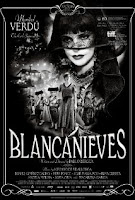I was thrilled when "The Artist" won the best picture Oscar last year, because I'd thought silent movies were a lost art. I expected to go another 10 or 15 years without seeing one, but here comes "Blancanieves" to prove me wrong. (It's at Park Terrace now, but don't delay: Who knows how long it'll stay?)
Spanish writer-director Pablo Berger has proven you can tell an intense, dramatic story without speaking a word (and by using even fewer title cards than "The Artist" did). He has updated the story of Snow White to Spain in the late 1920s, where the title character becomes a bullfighter like her famous father. He makes the story even Grimmer than the original: There are still a jealous stepmother and a poisoned apple and dwarves -- bullfighting dwarves -- but the ending is heartbreaking, and the overall tone is dark indeed.
Cinematographer Kiko de la Rica has shot a sumptuous, deep-toned picture in black-and-white, which goes with the wordless approach. For the first few minutes, the lack of dialogue seems like a gimmick, though the musical score and sound effects fill in the background. Then the technique becomes not only natural but apt: This is a story that works best with grand gestures, close-ups of faces that are horridly angry or roaring with delight.
We have forgotten now that all movies were told this way from the 1890s through 1927, when sound became widely available. (Some directors, notably Charlie Chaplin, stuck to the technique longer.) They fell out of favor only when the public jumped at the chance to hear actors speak. (So, too, did black-and-white cinematography start to vanish once color was perfected. That's also a shame.)
Talking movies aren't automatically better; they're simply different, the way Broadway musicals aren't "better" than opera. The story being told ought to determine the medium, though of course mass audiences won't sit still these days without spoken dialogue. (Total box office for "The Artist" didn't amount to one week of grosses for a disposable piece of nonsense such as "Oblivion.")
There are many ways to tell a beautiful, funny, frightening or emotionally harrowing story, and sound and color are just two of the tools in the filmmaker's workshop. I'm glad some directors still remember that.
Monday, April 22, 2013
Subscribe to:
Post Comments (Atom)









0 comments:
Post a Comment